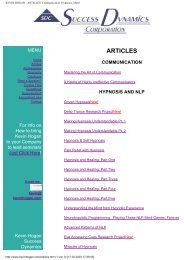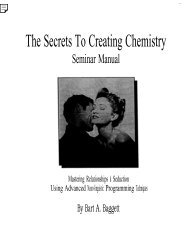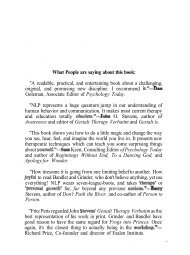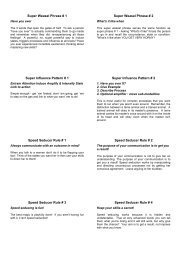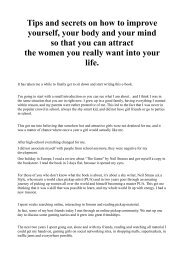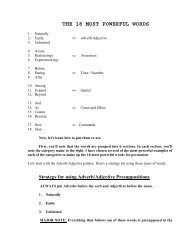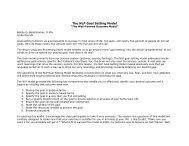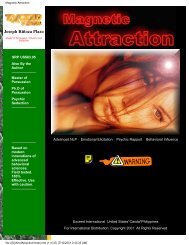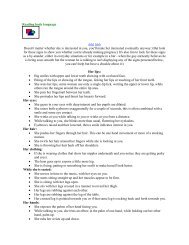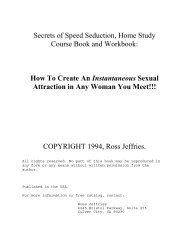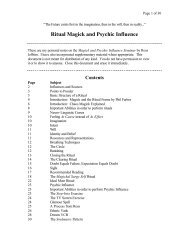A Pragmatic Guide To Communication & Change.pdf - NLP Info Centre
A Pragmatic Guide To Communication & Change.pdf - NLP Info Centre
A Pragmatic Guide To Communication & Change.pdf - NLP Info Centre
- No tags were found...
Create successful ePaper yourself
Turn your PDF publications into a flip-book with our unique Google optimized e-Paper software.
of elegant tools for organizing and describing our observations. 'there are three mechanisms<br />
common to all model-building activities: generalization, deletion, and distortion.<br />
Bandler and Grinder call these the "universal human modeling processes.- These three<br />
processes operate at every stage in the construction and use of our models of the world.<br />
They underlie our abilities to<br />
There is an interesting exhibit at the "Rxploratorium" in San Francisco. Two halfinch<br />
copper tubes are wound side-by-side around a wooden dowel. Warm fluid is piped<br />
through one tube, while cold fluid flows through the other. It is quite a shock to touch or<br />
grasp the bundle: the simultaneous sensations of warm and cold produce an extremely hot<br />
or burning sensation. It is fun to watch disbelieving people jump after reading the<br />
description and then, thinking they will be able to discern the difference, take a firm grasp<br />
of the bundle!<br />
H~ ~Ii,F<br />
It is my goal that the psychological and behavioral models presented in this book will<br />
operate as Hall suggests. That is, they will reduce the complexities of human<br />
communication into a more easily perceived and understandable framework ultimately<br />
enabling you to direct yourself and others toward a healthy and positive future.<br />
The Nerve Cell<br />
The nerve cell represents the first step in the creation of our models of the world. The<br />
basic units of the nerve cell are shown below.<br />
Neurological Basis<br />
Our romance with constructing models of our experience of the world may have a basis in<br />
psychobiological processes. We cannot escape the limitations imposed by our biological<br />
origins. As the noted Carl Jung observed:<br />
Man. . . never perceives anything fully or comprehends anything completely. He<br />
can see, hear, touch, taste; but how far he sees, how well he hears, what his<br />
touch tells him, and what he tastes depend upon the number and quality of his<br />
senses.... No matter what instruments he uses, at some point he reaches the edge<br />
of certainty beyond which conscious knowledge cannot pass. (p. 21)<br />
Man and His Symbols<br />
In our constant attempts to understand, driven by some intrinsic need to explore and<br />
explain, we create our models. But we are inexorably separated from the world outside<br />
ourselves.' Neural transmission, the basis of what we call perception, is a bioelectric<br />
phenomenon. Billions of neurons make up the human nervous system. Even though<br />
sensory input varies from pressure to temperature to sound to electromagnetic waves,<br />
they are all ultimately transformed into electrochemical impulses as they are transmitted<br />
to the central nervous system. The study of this miraculous transmutation of energy leads<br />
us to a fundamental aspect of experience: we do not perceive reality, but rather a<br />
neurological model of reality. ']'his is what forms the basis for what I call our model of<br />
the world.<br />
1. Cell body containing nucleus.<br />
2. Dendrites. These extend from the cell body and form the "receiving area" for<br />
stimulation from outside the body and from other adjacent cells.<br />
3. Axorr. This single fiber transmits the bioelectric impulse to the axon terminal.<br />
4. Axon terminal. This is the part of the nerve cell that activates other neurons on



